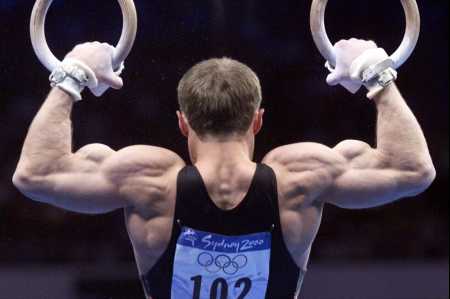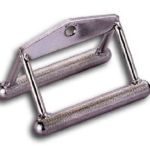 The biceps are the most coveted muscle group known to man. Since the first bodybuilding mag ever hit the stands, the biceps has been a showcase muscle and building an impressive set is a big business.
The biceps are the most coveted muscle group known to man. Since the first bodybuilding mag ever hit the stands, the biceps has been a showcase muscle and building an impressive set is a big business.
Yet, most guys can’t get the damn things to grow.
So I’m going to outline the three best biceps exercises to catapult your development. But before I do that, let me explain two common errors.
First, the biceps are designed to work with your forearms and upper back. Many machines take those muscles out of the movement so the biceps are left in isolation. The biceps, like most muscle groups, only respond to exercises that challenge them to work the way they’re designed. Just check out the picture in this blog. I used an Olympic rings gymnast for good reason. Those dudes have the most impressive biceps on the planet, but they aren’t bodybuilders that do machine curls all day. Instead, they’re athletes that hang from the rings for hours each day. Exercises on the rings challenge your forearms and upper back, along with your biceps. That’s why their biceps are so incredible – they train them with the muscles they’re designed to work with.
Biceps Training Error #1: Training the biceps in isolation.
Second, the biceps respond best to high training loads. Guys love to train for a pump, and the best way to get a pump is to do slow-grind sets with high reps. But slow training with long sets don’t overload the largest motor units that have the most potential for growth. You need to do multiple sets of low reps with a relatively heavy load to get the biceps to grow. This is why so many people love the 10×3 (10 sets of 3 reps) approach I often recommend for building a muscle group. The biceps respond especially well to that set/rep combination.
Biceps Training Error #2: Training the biceps with light loads and high reps.
With that out of the way, let’s get to the three best exercises that will quickly add muscle.
1. Rope Climb/Neutral grip Pull-up: Of all the exercises I’ve used that overload the biceps, the best one is the least practical. I’m talking about climbing a rope. If you have the luxury of hanging a 2″-2 1/2″ rope from 15 feet up, consider yourself lucky. All you need to do is climb up and down that rope for 10 sets 2-3 times per week and you’ve get all the biceps stimulation you’ll ever need.
But I know that’s not practical for most. The next option is to do pull-ups with a narrow, neutral (palms facing each other) grip. I’ve often talked about the benefit of pull-ups to build the biceps and some coaches scoff at the idea claiming that the stronger upper back will take over the exercise and biceps won’t grow. This is only true with pull-up variations that give the upper back muscles an effective line of pull. By placing your hands close together with your palms facing each other, your arm flexors are effectively targeted and the upper back can’t take over.
I’m sure you’re familiar with the Double D attachment that you see sitting next to the cable stack in your gym. Grab that attachment with both hands and look at how close together your hands are – that’s the perfect hand placement for pull-ups. Perform 10 sets of 3-5 reps while alternating it with a chest or triceps exercise.
cable stack in your gym. Grab that attachment with both hands and look at how close together your hands are – that’s the perfect hand placement for pull-ups. Perform 10 sets of 3-5 reps while alternating it with a chest or triceps exercise.
2. Palms-up Row: A barbell row is one of the best upper back exercises, but it’s also an outstanding biceps exercise when you perform it with your palms up and hands wider than shoulder width. Dorian Yates, the great bodybuilder with impressive biceps, made that exercise famous and he called it the “Yates Row.”
The tricky part of a bent-over barbell row is that it’s very easy to mess up the exercise by leaning back or bringing your hips into play. Therefore, I recommend a more effective, user-friendly alternative. First, set an adjustable bench to a 45 degree angle. Next, lie face-down on the bench while holding a moderately heavy dumbbell in each hand. Start with your arms hanging straight down, palms facing forward, and row the dumbbells. This takes your lower body out of the exercise and ensures that your arms and upper back are doing the work. Perform 10 sets of 3-5 reps while alternating it with an exercise for your chest or triceps.
3. Standing Hammer Curl/EZ bar Reverse Curl: I’m not against direct arm training exercises. They certainly have their place, but many variations do next to nothing. The two best I’ve used in 17 years are the standing hammer curl and standing reverse curl with an EZ bar. For these exercises I like to use slightly higher reps: 6 sets of 6-8 reps works well. Again, you should alternate each set with an exercise that trains your chest or triceps.
The essential component for getting the most out of your direct arm training exercises is to challenge your forearms. That’s why I highly recommend Fat Gripz. They fit around any traditional barbell, dumbbell, or pull-up bar and they work incredibly well to overload your biceps and forearms. Fat Gripz are one of the best training tools out there. Just throw a pair in your gym bag and you’ve got an excellent tool to make any arm exercise more effective.
You can find Fat Gripz by clicking HERE.

Stay focused,
CW
